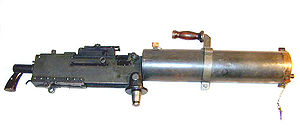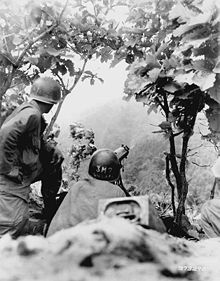Browning M1917
| Browning M1917 | |
|---|---|

|
|
| general information | |
| Military designation: | Browning M1917 |
| Country of operation: | International |
| Developer / Manufacturer: | Browning |
| Development year: | 1901 (1917) |
| Manufacturer country: | United States |
| Production time: | 1917 to 1975 |
| Model variants: | M1917, M1917A1 |
| Weapon Category: | Machine gun , water-cooled |
| Furnishing | |
| Overall length: | 609 mm |
| Technical specifications | |
| Caliber : | various calibers: .30-06 (USA), .303 British (UK), 6.5 × 55 mm (SW) |
| Ammunition supply : | Ammunition belt with 250 cartridges |
| Cadence : | 450 (600 for M1917A1) rounds / min |
| Fire types: | Continuous fire |
| Number of trains : | 4th |
| Twist : | right |
| Visor : | open sights |
| Closure : | Block closure |
| Charging principle: | Recoil loader |
| Lists on the subject | |
The Browning M1917 is an American machine gun which was used by the US armed forces in the First World War , in the Second World War , in the Korean War , in small numbers in the Vietnam War and in the same period also by other nations. Structurally, the weapon was usually assigned to the battalion's independent machine-gun company or as on- board armament, e.g. B. mounted on off-road vehicles. There were two main variants: the M1917, which was mainly used by the infantry during the First World War and in small numbers as an on-board weapon in aircraft, and the M1917A1, which was introduced after the war.
At the instigation of General John Pershing, the Browning M2 was developed from the M1917 through enlargement .
history
In 1901 gave John Browning , the US Patent 678,937 and for an automatic blowback weapon. The construction was not very popular with the US military at the time. The M1917 was basically a further development of this patent. The Browning M1917 is a water-cooled machine gun. After the First World War, air-cooled test weapons led to the lighter model 1919, which had the same mechanical structure. The Browning MG M1917 looks like the Maxim machine gun , has a belt feed and both are recoil loaders with a short recoil. Nevertheless, they are completely different mechanically. The Maxim has a knee joint lock, while the Browning MG locks the breech and barrel with a steel block. The Browning MG M1917 is slightly lighter than the Maxim and just as reliable.
The American United States Army Ordnance Department (comparable to the Heereswaffenamt or Office for Defense Technology and Procurement) showed little interest in the weapon until Browning was asked to test the weapon after the declaration of war in 1917. The first test was a success, but the weapons office requested a second test. In the second test, Browning fired two bursts of 20,000 rounds each without any malfunction. The weapons office reacted impressed, but was not convinced that this would also be possible with a production model. Browning produced a second prototype and fired 21,000 rounds in 48 minutes, again without any malfunction. The weapons office was then convinced and ordered the weapon, which was the beginning of a long career. The M1917 was still used in Korea.
In the meantime, the US Army used various older machine guns, for example the Colt-Browning M1895 (a gas-operated loader designed by Browning ), the Maxim , the Benet-Mercies M1909 and the Hotchkiss M1914 . The M1917 was intended as the standard weapon for the US Army in the war, but it came too late. The French Hotchkiss machine guns in 8 mm caliber were de facto the most widely used machine guns of the American Expeditionary Force .
commitment

The M1917 was only used in limited numbers during the First World War. Only 1,200 M1917s were used at the front in the last two and a half months. A third of the divisions ordered to France were equipped with the M1917. The remaining divisions used French or British Vickers machine guns made by Colt in the United States. Wherever the M1917 was used, its reliability and rate of fire were extremely effective.
The M1917A1 was also used in World War II. A few .303 British caliber specimens were shipped to Great Britain for British home defense. All models produced were used to compensate for the loss of a large part of the military equipment of the British Army during the hasty retreat from the German troops in France in 1940.
In the Korean War, the M1917 was used again in combat.
In the 1960s, the M1917 began to be replaced by the lighter and more manageable M60 for the “modern war”. The main tactics of the M1917 and the identical Vickers models, to operate defensively from a static position, were no longer up to date in times of fast and highly mobile warfare. Many M1917s were left to the South Vietnamese .
The weapon was used in various third world countries in the second half of the 20th century .
variants
Variants of the US military
M1917
First model. Use in the First World War.
M1917A1
Reactivated M1917 for the US arsenal, extended service life
M1918
- air-cooled version as aircraft on-board armament. Developed during the First World War, the M1918 came too late to be used, but remained in existence until the M1919 was introduced.
- heavier tube, but lighter tube jacket compared to the M1917
- a likely sub-variant, the M1918M1, was developed as a flexible version for the static M1918
International variants and names
The design of the M1917 was used in various models in many countries around the world and was given new names.
Ksp m / 36
- Name for the M1917 manufactured in Sweden under license in caliber 6.5 × 55 mm as an infantry weapon, and in caliber 8 × 63 mm as on-board armament for aircraft. In the mid-1970s, all models were converted to the NATO caliber 7.62 × 51 mm NATO . In contrast to the M1917 with a single handle, it has a double handle.
Ckm wz. 30th
- Polish, improved license build of the M1917 in caliber 7.92 × 57 mm
M / 29
- Norwegian name for the Colt M1917 (so called in this section) in 7.92 mm caliber, used as a heavy standard machine gun and as an anti-aircraft weapon for the Norwegian Army from 1919 to 1940. Replaced the Hotchkiss M1914 . In the 1940 war against the German Wehrmacht, the M / 29 mostly proved itself as the only available heavy machine gun.
Commercial variants
Colt Model 1917 and Model 1928
- Colt produced the M1917 for an Argentine export order as a model 1928 in a slightly different way: the model 1928 got a thumb protection, a muzzle brake and a device for a vision visor
Colt MG38, MG38B, and MG38BT
- Derivatives of the Colt M1928 for commercial use
- the MGs 38 and 38B were water-cooled with a tubular jacket that, in contrast to the Colt M1917 and M1928, was screwed into the housing.
- the MG 38BT was an air-cooled gun with a short heavy barrel similar to the M1919A2 and was used as a Panzer MG
Derivatives
A simplified, air-cooled version of the weapon, the M1919A2 , was introduced after World War I and used in World War II, the Korean War, and the Vietnam War.
Trivia
A Browning M1917 machine gun was the focus of the final shootout in Sam Peckinpah's 1969 film The Wild Bunch .
literature
- Günter Wollert, Reiner Lidschun: Infantry weapons yesterday . (1918-1945). In: Illustrated encyclopedia of infantry weapons from around the world . 3. Edition. tape 2 . Brandenburgisches Verlagshaus, Berlin 1998, ISBN 3-89488-036-8 , weapons, p. 372-375, 569-571 .
- Gordon L. Rottman: Browning .30-caliber Machine Guns , Bloomsbury Publishing, 2014, ISBN 978-1-4728-0804-2 . (81 pages online PDF)
Individual evidence
- ^ Competition Cartridges - A Brief History of Cartridge Design. 6mmbr.com, accessed April 27, 2013 .
- ^ Norwegian weapons. Colt mitraljöse m / 29 (7.92 mm) heavy machine gun. (No longer available online.) Archived from the original on July 16, 2011 ; accessed on April 27, 2013 (English). Info: The archive link was inserted automatically and has not yet been checked. Please check the original and archive link according to the instructions and then remove this notice.
Web links
- O. Janson: The Swedish machineguns before 1950. Kulspruta m / 36 (KSP m / 1936) Swedish Medium Machine Guns - Browning system. January 23, 2007, accessed on April 27, 2013 (English, images of the M1917, sectional images, disassembled weapon using the example of the derivative Ksp m / 36).
